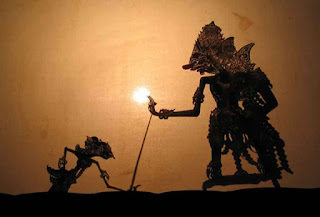I had meant to put
up a post about articulated collage when I was responding to the William
Kentridge exhibition. He has made several films using simple articulated black
card figures as the main protagonists. However I had not thought about how far
you could take this basic collage technique until I found the work of Tim
Hawkinson. "Emoter," consists of cut out ink-jet prints taken from
photographs of Hawkinson’s own face and mounted on card, so that they can be
jointed in such a way that when moved they mimic how Hawkinson’s own facial
features move. He has turned his own
face into a machine that can take on any expression by combining all those
little facial movements that we make when effecting face-to-face communication.
However by making the whole face from cut-outs the work is slightly disturbing,
especially as the face is over life sized. The machinery used to drive the
cutouts also uses clear plastic tube linkages which give an almost clinically abject
quality to what we are looking at. It’s in the articulation of small lip and
eye movements, (see animation clips) that the work begins to move beyond what
you might expect from this type of approach and it is when he gets down to such
small details that he ensures that the work has maximum effect.
Tim Hawkinson: 'Emoter'
Hawkinson uses computer software to drive the machines that move his collage elements, but this could easily be done by hand. This might seem a long
way from Indonesian shadow puppets but is essentially the same technique. Take
some flat cut out shapes based on sections of the human body and link them
together with a jointing system.
Indonesian shadow puppets
Both William Kentridge and Kara Walker have made use of the flat black card cut-out technique to create short narrative films. Working this way can make for a very powerful and emotive experience for the audience.
William Kentridge constructing an articulated horse out of torn black paper.
Find a large scale Kentridge work that begins to combine real footage with shadow play here
A Kara Walker projection
You can find a video of Kara Walker talking about her work here.
The issue here is that a very old technique, (the making of flat articulated human figures), can always be revisited. However the way an old technique is approached and received by a new audience will of course depend on the factors that shape a society and the technical climate that it exists within. In a time of social media and the prevalence of the 'selfie', how could these techniques be used to make people more aware of issues such as the fragmented nature of the current political climate, or the rise of Islamophobia?
Shadow projection does not of course have to be done using cutout articulated figures, it can simply be a light projected one an object in such a way that its shadow is projected onto another surface. It can be done in a variety of ways, a very simple thing to do is to make a projection beam pass through a group of moving figures, such as in Hans Peter Feldmann's; "Shadow Play".
Hans Peter Feldmann: Shadow Play
Christian Boltanski: Theatre d'Ombre
In Boltanski's work the movement is simply the swinging motion that you get when you hang things from a frame. The heat from the lamps causes air currents that ensure the shapes are always moving.
You don't need to make the shadows move to make interesting work, Rashid Alakbarov constructs shadows of cities from ordinary domestic objects.
Rashid Alakbarov
Alakbarov's technique is very simple, as you can see it doesn't take a lot of ingenuity to come up with interesting images once you have set up your light source properly. Why not stay late for a couple of evenings and try using an OHP or any other light source to make a shadow world? Make sure you photograph the results really well and the next morning in the fresh light of a new day re-evaluate what has happened. This old technique is very powerful and would have been used by cave artists to great dramatic effect, so don't dismiss it as child's play and only worthy of making rabbit and crocodile shadows to entertain the children at bed time.
Rashid Alakbarov at work.
See also:
Children at play. A Frances Alys book, that reminds us that shadow play begins with children.













No comments:
Post a Comment